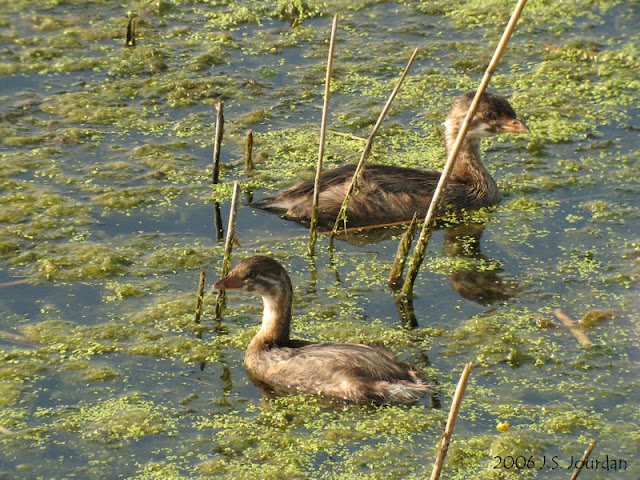Evening at Pt. Mouillee - 28 Jul 2006
I rode the dikes at Pt. Mouillee between 4:30 - 7:30pm. From the Mouillee Creek entrance (parking area just north of Roberts Rd. off US-Turnpike) a pair of SWAMP SPARROWS could still be heard singing, but not seen. American Goldfinches were in abundance, and curiously I saw/heard no Indigo Buntings between the entrance and the Banana. The north end of Cell 3 had a lot of adult and 1st year Herring Gulls as well as Caspian Terns and Forsters Terns. The following shorebirds were present:
48 Peeps - mostly Semipalmated Sandpipers (two fresh juveniles included)
2 - Lesser Yellowlegs
4 - Short-billed Dowitchers
6 - Spotted Sandpipers
2 - Killdeer
2 - Semipalmated Plovers
Otherwise, lots of juvenile American Coots and Pied-billed Grebes, Black-crowned Night Herons, Great Egrets, Great Blue Herons and (6) Baltimore Orioles were observed.
0430 Hrs. I took a ride down to Pt. Mouillee and rode the dikes from the Mouillee Creek entrance. Its hot, and windy. 85F with clear/slightly hazy skies. As I enter the SGA I quickly heard a pair of Swamp Sparrows singing in the cattails next to the creek. I stopped for a few moments but was unable to see anything. American Goldfinches are out in force and quite actively nesting. A pair of Spotted Sandpipers and a Great Egret are all that’s visible in the marsh areas. I’m quickly aware that Indigo Buntings don’t seem to be around – this is odd ‘cause you’ll hear them singing and flying about. American Coots are all over in various stages of maturity. Lots of immature birds starting to take on an ashy gray color all over, while some young, white-headed birds are still about.
As I approach the north end of Cell 3 I can see lots of peeps and a few Short-billed Dowitchers from a distance. I stop behind a large stand of trees and set up the scope and quickly scan the shoreline. There are lots of Caspian and Forsters Terns on the shoreline, and a huge flock of Herring/Ringbilled Gulls up on the mud flats/dike area. I’m too far to digiscope anything, and its too windy. I decide to ride down and verify that Cell 2 is still growing in. I’m hoping that there might be some water in it as we’ve had 2-3 inches of rain the last 2 nights.
Cell 2 is bone dry and starting to look like an emergent grassland. As I stand and observe the now large field of grasses I can only hope that it might attract some sparrows next year. Meanwhile, there are lots of dragonflies/darners flying about, and I try to take a few pictures w/ the 400mm lens.
On the way back toward Cell 3 I spotted several immature Baltimore Orioles flying along the dike and landing in the willows and junipers. A single Eastern Kingbird is perched only a few feet away and appears to be oblivious to my presence. I set up the scope and begin digiscoping the bird, getting full frame images.
Mom calls about going up north, and as I talk to her I’m continuing to take pictures through the scope. The kingbird continues to perch, and is preening, giving me numerous shots as it gyrates its body in all sorts of contours. Nearby a Lesser Yellowlegs poses for a few pics.
A few moments later I spotted a pair of immature Pied-billed Grebes and spend the next 10 minutes or so digiscoping them from up close.
As I return to Cell 3 I’m now close enough to get a count of the peeps (48) and after assuming them all to be Least Sandpipers, I start hearing the ‘machine-gun’ chatter of Semipalmated Sandpipers. A pair of immature birds are among the dull, alternate plumaged adults. The immatures are striking brown w/ feathers that have white tips.
Several Spotted Sandpipers are also present, and give me a challenge of trying to digiscope them while they continue to walk up and down the shoreline below me.
A single young Herring Gull appears to be stuck in the mud at shore’s end, and its beak is caked in mud. It won’t make it through the night. A sad sight to observe, as there’s nothing anyone can do for it.
A scan of the shoreline also nets a pair of Semipalmated Plovers and another pair of Short-billed Dowitchers. In all I counted six dowitchers and another dozen Spotted Sandpipers.
As I ride back toward the car I spotted a single male Wood Duck in eclipse plumage sitting among the Lotus leaves. Its perfectly still, and has its eyes on me the whole time I’m setting up to photograph it. After a couple dozen images it finally drops into the water and is soon joined by a baby Wood Duck that was hiding among the Lotus leaves.
Jul 28, 2006 4:30 PM - 7:30 PM
Protocol: Traveling
8.0 mile(s)
21 species
Wood Duck (Aix sponsa) 2
Pied-billed Grebe (Podilymbus podiceps) 4
American Coot (Fulica americana) 36
Killdeer (Charadrius vociferus) 2
Semipalmated Plover (Charadrius semipalmatus) 2
Short-billed Dowitcher (Limnodromus griseus) 4
Spotted Sandpiper (Actitis macularius) 6
Lesser Yellowlegs (Tringa flavipes) 2
Least Sandpiper (Calidris minutilla) 2
Semipalmated Sandpiper (Calidris pusilla) 46
Ring-billed Gull (Larus delawarensis) 40
Herring Gull (Larus argentatus) 22
Caspian Tern (Hydroprogne caspia) 12
Forster's Tern (Sterna forsteri) 9
Black-crowned Night Heron (Nycticorax nycticorax) 6
Great Egret (Ardea alba) 12
Great Blue Heron (Ardea herodias) 4
Eastern Kingbird (Tyrannus tyrannus) 1
American Goldfinch (Spinus tristis) 14
Swamp Sparrow (Melospiza georgiana) 2
Baltimore Oriole (Icterus galbula) 6
View this checklist online at https://ebird.org/checklist/S1
This report was generated automatically by eBird v3 (https://ebird.org/home)






















Comments
Post a Comment
Please leave a comment. I will try to respond ASAP.